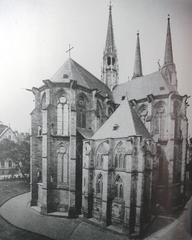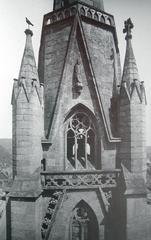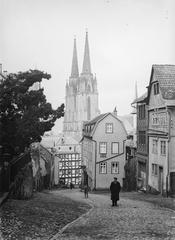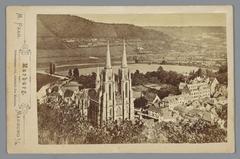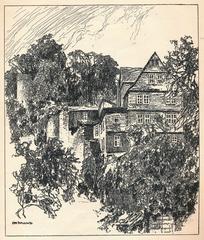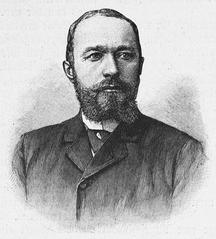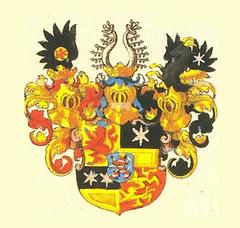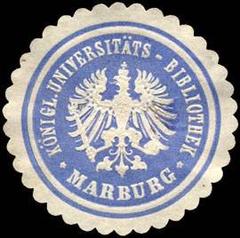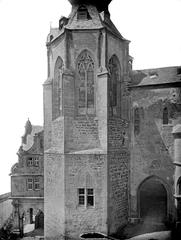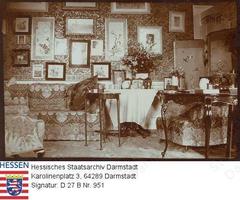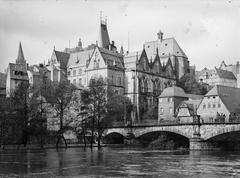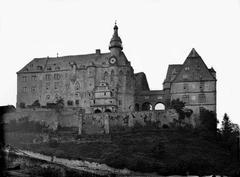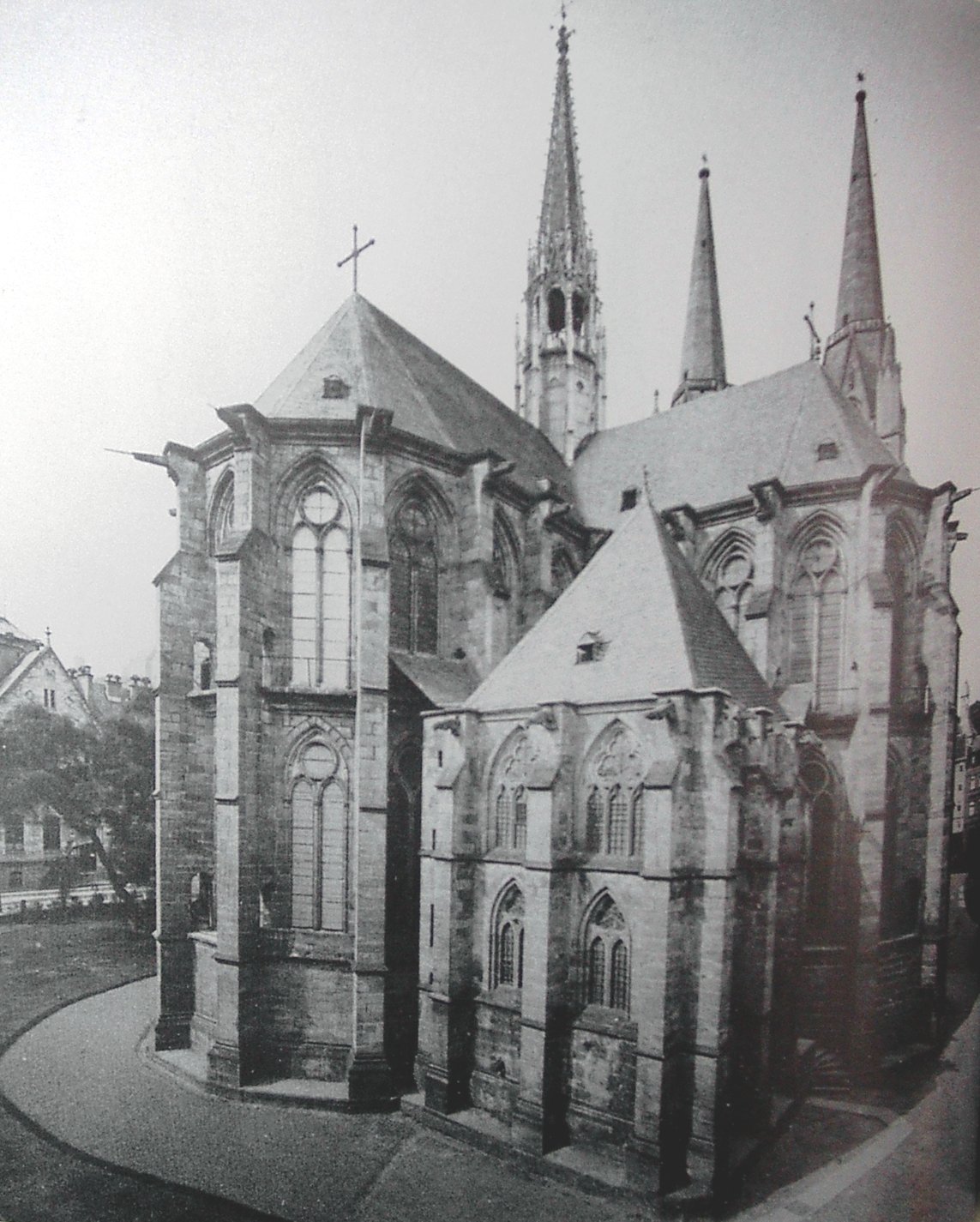
St. Elisabeth’s Church Marburg: Visiting Hours, Tickets, and Historical Significance
Date: 14/06/2025
Introduction
St. Elisabeth’s Church (Elisabethkirche) in Marburg, Germany, stands as a masterpiece of early Gothic architecture and a profound symbol of religious and cultural heritage. Built beginning in 1235 over the tomb of St. Elisabeth of Hungary, the church was commissioned by the Teutonic Order and rapidly became one of the most significant pilgrimage destinations in medieval Europe. Today, its twin towers and radiant stained glass windows draw visitors seeking spiritual reflection, architectural inspiration, or a deeper understanding of Marburg’s rich history (Marburg Tourism, UNESCO World Heritage Nomination, Catholic Encyclopedia).
The church has survived religious reforms, wars, and centuries of change, evolving from a Catholic pilgrimage hub to a Protestant parish while preserving its artistic treasures and charitable legacy. This comprehensive guide provides essential visitor information—opening hours, ticketing, accessibility, and nearby attractions—alongside insights into the church’s origins, architectural innovations, and enduring impact (Elisabethkirche Official Website, Marburg University).
Table of Contents
- Origins and Construction
- Life and Legacy of St. Elisabeth of Hungary
- Architectural Features and Artistic Highlights
- Pilgrimage and Religious Significance
- The Teutonic Order’s Role
- Reformation and Later History
- Restoration and Preservation
- Visiting Hours, Tickets, and Accessibility
- Guided Tours and Visitor Etiquette
- Nearby Attractions and Travel Tips
- Frequently Asked Questions (FAQs)
- Conclusion and Visitor Recommendations
- Sources and Further Reading
Origins and Construction of St. Elisabeth’s Church
St. Elisabeth’s Church is one of Germany’s earliest and most influential Gothic churches. Construction began in 1235, spurred by the canonization of St. Elisabeth of Hungary. The Teutonic Order oversaw the project, establishing the church as a monument to Elisabeth’s charity and as their principal place of worship (Marburg Tourism). Key construction milestones include:
- 1249: Completion of the choir
- 1283: Nave finished
- 1340: Twin towers completed
Inspired by French Gothic cathedrals, the Elisabethkirche features pointed arches, ribbed vaults, and flying buttresses, signifying a decisive move away from Romanesque styles (UNESCO World Heritage Nomination).
Life and Legacy of St. Elisabeth of Hungary
St. Elisabeth of Hungary (1207–1231) was renowned for her tireless care for the sick and poor. Married to Landgrave Ludwig IV of Thuringia, she later dedicated her life to charitable works in Marburg, founding a hospital for the needy. Her sanctity was recognized quickly, leading to her canonization in 1235. Her tomb within the church became a magnet for pilgrims, further elevating the church’s spiritual stature (Catholic Encyclopedia).
Architectural Features and Artistic Highlights
Structural Overview
St. Elisabeth’s Church is a three-aisled basilica, approximately 80 meters in length, with its iconic twin towers soaring to 80 meters high (Marburg University). Hallmarks of its design include:
- Double choir: Allows both monastic and public worship
- Slender columns and ribbed vaults: Creating a luminous, uplifting interior
- Ambulatory: Permits pilgrims to venerate the shrine without interrupting services
Artistic Treasures
- Stained Glass: Medieval and modern stained glass, including a notable 1957 window by Charles Crodel, bathes the interior in vibrant light.
- Shrine of St. Elisabeth: A late-13th-century masterpiece of goldsmithing, housing the saint’s relics.
- Altars: The high altar and side chapels display intricate Gothic and Baroque artworks.
Mausoleum and Graves
The church houses the tombs of the Landgraves of Hesse and contains archaeological evidence of medieval pilgrim burials, underscoring its role as a sacred destination.
Pilgrimage and Religious Significance
From the Middle Ages onward, St. Elisabeth’s Church attracted thousands of pilgrims annually, drawn by the saint’s miracles and papal indulgences (Deutsche Stiftung Denkmalschutz). The influx of visitors fostered Marburg’s growth, leading to the development of infrastructure such as hospitals and hostels for pilgrims. The church remains a living site of worship, with important liturgies, concerts, and cultural events throughout the year.
The Teutonic Order’s Role
The Teutonic Knights, a powerful religious and military order, were instrumental in the church’s construction and stewardship. The church served as their main spiritual center in Germany, hosting investitures and key ceremonies. It also became the burial place for several Hessian landgraves, highlighting the intertwining of religious and dynastic history (komoot.com).
Reformation and Later History
The Protestant Reformation in the 16th century transformed the church’s religious identity. In 1527, Landgrave Philip I of Hesse removed Elisabeth’s relics, and the church became Protestant, though it retained its architectural integrity and artistic heritage (Marburg City History). The church survived subsequent upheavals, including the Thirty Years’ War, with only minor damage.
Restoration and Preservation
Extensive restoration between 1854 and 1888 under Prussian authority ensured the church’s survival (German National Tourist Board). Ongoing conservation projects protect its structure and artworks. The church is listed on Germany’s tentative UNESCO World Heritage list, reflecting its outstanding universal value.
Visiting Hours, Tickets, and Accessibility
-
Typical Visiting Hours:
- April–October: 10:00 am–6:00 pm
- November–March: 10:00 am–4:00 pm
- Sunday/public holidays: Check the official website for any changes during religious services or special events.
-
Admission:
- Main sanctuary: Free of charge (donations welcome)
- Guided tours, special exhibitions, or access to chapels: Small fee may apply
-
Accessibility:
- Main entrance and nave are wheelchair accessible
- Accessible restrooms available
- Some historic areas (crypts, upper galleries) may have limited access; contact staff for assistance
Guided Tours and Visitor Etiquette
-
Guided Tours:
- Available in German and English by prior arrangement (marburg-tourismus.de)
- Tours provide in-depth history, art, and architecture insights
-
Etiquette:
- Modest dress (shoulders and knees covered)
- Remain quiet, especially during services
- Photography generally allowed (no flash or tripods; observe local signage)
Nearby Attractions and Travel Tips
- Marburg Castle (Landgrafenschloss): Museum and panoramic views (Eupedia)
- Old Town (Oberstadt): Half-timbered houses, shops, and cafés
- Philipps-Universität Marburg: Germany’s oldest Protestant university
Travel Tips:
- Arrive early to avoid crowds
- Combine your church visit with other historical sites
- Use public transport or walk; parking is limited in the city center
Frequently Asked Questions (FAQs)
What are the visiting hours?
April–October: 10:00 am–6:00 pm; November–March: 10:00 am–4:00 pm; check the official website for updates.
Is there an admission fee?
Entry to the main sanctuary is free; some tours and exhibitions require a fee.
Are guided tours available in English?
Yes, by prior arrangement.
Is the church wheelchair accessible?
Yes, the main entrance and nave are accessible; some areas may be restricted.
Can I take photos inside?
Yes, generally permitted without flash; follow on-site instructions.
Conclusion and Visitor Recommendations
St. Elisabeth’s Church is not only an architectural marvel but a living symbol of Marburg’s spiritual and cultural legacy. From its origins as a pilgrimage site to its ongoing role as a vibrant parish and historical monument, the church invites visitors to explore centuries of faith, charity, and artistry. With accessible facilities, guided tours, and proximity to other attractions, it is a highlight of any visit to Marburg. For the best experience, consult the official website for up-to-date information and enhance your visit with interactive guides like the Audiala app.
Sources and Further Reading
- Marburg Tourism
- UNESCO World Heritage Nomination
- Catholic Encyclopedia
- Marburg University
- Deutsche Stiftung Denkmalschutz
- German National Tourist Board
- Kulturportal Hessen
- Elisabethkirche Official Website
- komoot.com
- The Catholic Travel Guide
- Eupedia
- Marburg City History
